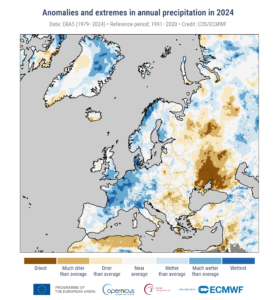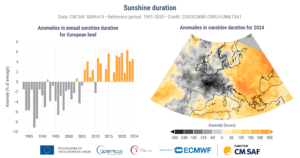Issued Tuesday 15th April 2025
Europe and Ireland
2024 was the warmest year on record for Europe, and the 4th warmest year on record for Ireland. The Copernicus Climate Change Service and World Meteorological Organization’s joint report, 2024 European State of the Climate, highlights that “Europe is the fastest-warming continent”, this is partly due to the proportion of European land in the Arctic, which is the fastest-warming region on Earth, and more frequent summer heatwaves. Ireland is more influenced by the surrounding sea, and is warming at a slower rate than continental Europe. However, as outlined in Met Éireann’s recent report on Ireland’s Climate in 2024, Ireland is warming in line with the global warming trend.

Figure 1: European surface air temperature anomalies show most areas of Europe being warmer than average, with many parts of central and eastern Europe experiencing their warmest ever temperatures. Data: ERA5 Credit: C3S

Figure 2 – Ireland’s temperature anomalies since 1900 show a clear increasing temperature trend. Credit: Met Éireann
The European report further outlines how: “Western Europe saw one of the ten wettest years in the analysed period since 1950.” In Ireland, after a wet beginning to the year we saw a slightly drier than average year overall (98% of Long Term Average), with below average rainfall in Ireland for 7 of the last 8 months of 2024 (Figure 3).

Figure 3: Precipitation anomalies show much of western Europe wetter than average in 2024 compared to the 1991-2020 reference period, while Ireland is near average. Data: ERA5 Credit: C3S
The area of European land that experienced fewer than three months (90 days) of frost days was the largest on record (~69%, the average is 50%), and here in Ireland, we are seeing a similar reduction in the number of frost days.
Met Éireann’s Climatologist Paul Moore said: “2024 was Ireland’s fourth warmest year on record, even though it may not have always felt that way, especially during the cooler than average summer months. It was often cloudy during 2024 and this, along with continued high sea surface temperatures across the North Atlantic, led to higher nighttime temperatures being more influential.”

Figure 4: (Left) Annual sunshine duration anomalies (%) for Europe for 1983–2024, showing positive (orange) and negative (grey) anomalies. (Right) Sunshine duration anomalies (hours) over Europe for 2024, showing positive (shades of orange) and negative (shades of grey) anomalies. Reference period: 1991– 2020. Data: CM SAF SARAH-3 CDR and ICDR. Credit: C3S/ECMWF/DWD/EUMETSAT.
Met Éireann’s recent 2024 Climate Statement explains that: “Although 2024 was overall drier than average, there were many instances of heavy or intense rainfall which led to flooding. Compound events, which involve multiple climate impact drivers occurring at the same time, are on the rise.” While other European countries experienced extreme flooding events, weather events such as storm Bert and its associated flooding have affected Ireland as well.
Paul Moore continued: “The main reason behind Ireland ‘only’ having its 4th warmest year on record in 2024 and Europe having its warmest year on record in 2024 is down to the synoptic setup or large-scale atmospheric patterns that developed during the summer months of 2024.
Summer 2024 saw the heat concentrated over central, eastern and southern Europe, whereas western Europe was relatively cool by comparison. This was due to persistent high pressure forming over the north Atlantic and low pressure over Scandinavia dragging down Arctic maritime airmasses over western Europe during June and July. This led to June and July being cooler and drier than average in Ireland and to summer 2024 being the first cooler than average season in Ireland since spring 2021.”

Figure 5: Anomalies and extremes in surface air temperature for June–August 2024. Colour categories refer to the percentiles of the temperature distributions for the 1991–2020 reference period. The extreme (“Coolest” and “Warmest”) categories are based on rankings for the period 1979–2024. Data source: ERA5. Credit: Copernicus Climate Change Service/ECMWF.
Carlo Buontempo, the Director of the Copernicus Climate Change Service states: “2024 was the warmest year on record for Europe. We observed the longest heatwave in southeastern Europe and record glacier mass loss in Scandinavia and Svalbard. But 2024 was also a year of marked climate contrasts between eastern and western Europe. The European State of the Climate is a treasure trove of quality information about our changing climate. Learning how to use climate data and information to inform our decisions should become a priority for all of us”. Read the full report here: 2024 European State of the Climate (ESOTC) report